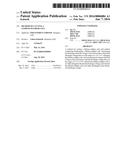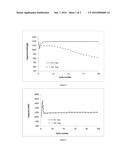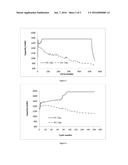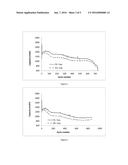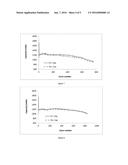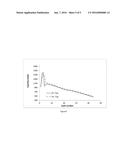Patent application title: METHOD OF CYCLING A LITHIUM-SULPHUR CELL
Inventors:
Lukasz Kabacik (Abingdon, GB)
IPC8 Class: AH01M1046FI
USPC Class:
320132
Class name: With charging cycling (e.g., discharge/charge cycle, etc.) with state-of-charge detection
Publication date: 2016-01-07
Patent application number: 20160006084
Abstract:
A method for cycling a lithium-sulphur cell, said method comprising
discharging a lithium-sulphur cell, terminating the discharge when the
voltage of the cell reaches a threshold discharge voltage that is in the
range of 1.5 to 2.1 V, charging the lithium-sulphur cell, and terminating
the charge when the voltage of the cell reaches a threshold charge
voltage that is in the range of 2.3 to 2.4V, wherein the lithium-sulphur
cell is not fully charged at the threshold charge voltage, and wherein
the lithium-sulphur cell is not fully discharged at the threshold
discharge voltage.Claims:
1. A method for cycling a lithium-sulphur cell, said method comprising:
i) discharging a lithium-sulphur cell, ii) terminating the discharge when
the voltage of the cell reaches a threshold discharge voltage that is in
the range of 1.5 to 2.1V, iii) charging the lithium-sulphur cell, and iv)
terminating the charge when the voltage of the cell reaches a threshold
charge voltage that is in the range of 2.3 to 2.4V, wherein the
lithium-sulphur cell is not fully charged at the threshold charge
voltage, and wherein the lithium-sulphur cell is not fully discharged at
the threshold discharge voltage.
2. The method of claim 1, wherein the threshold discharge voltage is about 1.75V.
3. The method of claim 1, wherein the threshold charge voltage is about 2.33V.
4. The method of claim 1, wherein steps i) to iv) are repeated for at least 2 discharge-charge cycles.
5. The method of claim 1, wherein steps i) to iv) are repeated for at least 20 discharge-charge cycles.
6. The method of claim 1, wherein the points at which charge and discharge are terminated occur when at least 80% of the cathodic sulphur material is dissolved in the electrolyte.
7. A battery management system for controlling the discharging and charging of a lithium-sulphur cell, said system comprising a termination device coupled to the coupling device, wherein the termination device terminates the discharge of -a-the lithium-sulphur cell at a threshold discharge voltage that is greater than the voltage of the cell in its fully discharged state, a charging device coupled to the coupling device, wherein the charging device is capable of charging the lithium-sulphur cell, and wherein the charging device is configured to terminate charging of the lithium-sulphur cell at a threshold charging voltage that is lower than the voltage of the cell in its fully charged state.
8. The system of claim 7, further comprising a voltage monitor configured to monitor the voltage of the lithium-sulphur cell during discharge and charge.
9. The system of claim 7, wherein the charging device terminates the discharge when the voltage of the cell is at 1.7 to 1.8 V.
10. The system of claim 9, wherein the charging device terminates the discharge when the voltage of the cell is at about 1.75 V.
11. The system of claim 7, wherein the charging device terminates the charge when the voltage of the cell is at 2.3 to 2.4 V.
12. The system of claim 7, wherein the charging device terminates the charge when the voltage of the cell is about 2.33V.
13. The system of claim 7, further comprising a coupling device configured to receive the lithium-sulfur cell and couple the lithium-sulfur cell to the termination device and the charging device.
14. The system of claim 7, further comprising a lithium sulphur battery.
Description:
[0001] The present invention relates to a method of cycling a
lithium-sulphur battery. The present invention also relates to a battery
management system for cycling a lithium-sulphur battery.
BACKGROUND
[0002] A typical lithium-sulphur cell comprises an anode (negative electrode) formed from lithium metal or a lithium metal alloy, and a cathode (positive electrode) formed from elemental sulphur or other electroactive sulphur material. The sulphur or other electroactive sulphur-containing material may be mixed with an electrically conductive material, such as carbon, to improve its electrical conductivity. Typically, the carbon and sulphur are ground and then mixed with a solvent and binder to form a slurry. The slurry is applied to a current collector and then dried to remove the solvent. The resulting structure is calendared to form a composite structure, which is cut into the desired shape to form a cathode. A separator is placed on the cathode and a lithium anode placed on the separator. Electrolyte is then introduced into the assembled cell to wet the cathode and separator.
[0003] Lithium-sulphur cells are secondary cells. When a lithium-sulphur cell is discharged, the sulphur in the cathode is reduced in two-stages. In the first stage, the sulphur (e.g. elemental sulphur) is reduced to polysulphide species, Sn2- (n≧2). These species are generally soluble in the electrolyte. In the second stage of discharge, the polysulphide species are reduced to lithium sulphide, Li2S, which, typically, deposits on the surface of the anode.
[0004] When the cell is charged, the two-stage mechanism occurs in reverse, with the lithium sulphide being oxidised to lithium polysulphide and thereafter to lithium and sulphur. This two-stage mechanism can be seen in both the discharging and charging profiles of a lithium-sulphur cell. Accordingly, when a lithium-sulphur cell is charged, its voltage typically passes through an inflexion point as the cell transitions between the first and second stage of charge.
[0005] Lithium-sulphur cells may be (re)charged by applying an external current to the cell. Typically, the cell is charged to a fixed cut-off voltage of, for example, 2.45-2.8. However, with repeated cycling over an extended period, the capacity of the cell may fade. Indeed, after a certain number of cycles, it may no longer be possible to charge the cell to the fixed cut-off voltage because of the increasing internal resistance of the cell. By repeatedly charging the cell to the selected cut-off voltage, the cell may eventually be repeatedly over-charged. This can have a detrimental effect on the longevity of the cell, as undesirable chemical reactions may lead to degradation, for example, the cell's electrodes and/or electrolytes
[0006] In view of the foregoing, it is desirable to avoid over-charging the lithium-sulphur cell. WO 2007/111988 describes a process for determining when a lithium sulphur cell is fully charged. Specifically, this reference describes adding an N--O additive, such as lithium nitrate, to the electrolyte of the cell. According to the passage at page 16, lines 29 to 31, of this reference, the additive is effective in providing a charge profile with a sharp increase in voltage at the point of full charge. Accordingly, if the cell voltage during charge is monitored, charging can be terminated once this rapid increase in voltage is observed.
[0007] The method of WO 2007/111988 relies on the voltage of the cell increasing very sharply as the cell reaches full capacity. Not all lithium-sulphur cells, however, exhibit such a charging profile.
SUMMARY OF THE INVENTION
[0008] According to the present invention, there is provided a method for cycling a lithium-sulphur cell, said method comprising:
[0009] i) discharging a lithium-sulphur cell,
[0010] ii) terminating the discharge when the voltage of the cell reaches a threshold discharge voltage that is in the range of 1.5 to 2.1V,
[0011] iii) charging the lithium-sulphur cell, and
[0012] iv) terminating the charge when the voltage of the cell reaches a threshold charge voltage that is in the range of 2.3 to 2.4V,
[0013] wherein the lithium-sulphur cell is not fully charged at the threshold charge voltage, and
[0014] wherein the lithium-sulphur cell is not fully discharged at the threshold discharge voltage.
[0015] Without wishing to be bound by any theory, it has been found that the rate of capacity fade can advantageously be reduced by under-charging and, optionally, under discharging the lithium-sulphur cell. When a lithium-sulphur cell is fully charged, the electroactive sulphur material, such as elemental sulphur, typically exists in its fully oxidised form (e.g. S8). In this form, the electroactive sulphur material is typically non-conducting.
[0016] Accordingly, when such a material (e.g. elemental sulphur) deposits on the cathode, the resistance of the cathode may increase. This may result in temperature increases, which, with prolonged cycling, may cause faster degradation of the cell's components. This, in turn, may reduce the capacity of the cell, and increase the rate of capacity fade. Similarly, when the cell is in its fully discharged state, lithium sulphide deposits on the negative electrode. This can also have the effect of increasing the cell's resistance. By under-charging and, optionally, under-discharging the cell, the amount of non-conducting species produced may be reduced, thereby reducing the resistance of the cell and the tendency for capacity fade.
[0017] In one embodiment, the cell is charged to points where a significant proportion of the cathodic sulphur material (e.g. elemental sulphur) is still dissolved in the electrolyte (e.g. as polysulphide). The cell may also be discharged to points where a significant proportion of the cathodic sulphur material (e.g. elemental sulphur) is still dissolved in the electrolyte (e.g. as polysulphide). Preferably, the points at which charge and, optionally, discharge are terminated occur when at least 80% of the cathodic sulphur material is dissolved in the electrolyte (e.g. as polysulphide). The percentage of cathodic sulphur material dissolved in solution can be determined by known methods, for example, from the amount of residual solid sulphur in a cell as a percentage of the initial amount of sulphur material introduced as the cathodic material.
[0018] The threshold discharge voltage is 1.5 to 2.1V, for example, 1.5 to 1.8 V or from 1.8 V to 2.1V. Suitable threshold discharge voltages range from 1.6 to 2.0 V, for example, 1.7 to 1.9 V. Preferably, the threshold discharge voltage is 1.7 to 1.8 V, preferably about 1.75 V.
[0019] Preferably, the threshold charge voltage is about 2.30 to 2.36 V, more preferably, 2.30 to 2.35V, yet more preferably 2.31 to 2.34V, for example, 2.33V.
[0020] In one embodiment, steps i) to iv) are repeated for at least 2 discharge-charge cycles, preferably for at least 20 discharge-charge cycles, more preferably for at least 100 cycles, for example, throughout the useful lifetime of the cell.
[0021] In one embodiment, the method further comprises the step of monitoring the voltage of the cell during charge and/or discharge.
[0022] The present invention also provides a battery management system for carrying out the method described above.
[0023] According to yet a further aspect of the present invention, there is provided a battery management system for controlling the discharging and charging of a lithium-sulphur cell, said system comprising
[0024] means for terminating the discharge of a lithium-sulphur cell at a threshold discharge voltage that is greater than the voltage of the cell in its fully discharged state,
[0025] means for charging the lithium-sulphur cell, and
[0026] means for terminating the charge at a threshold charging voltage that is lower than the voltage of the cell in its fully charged state.
[0027] Preferably, the system comprises means for monitoring the voltage of the cell during discharge and charge.
[0028] In one embodiment, the means for terminating the discharge of the cell terminates the discharge when the voltage of the cell is at 1.5 to 1.8, preferably at1.7 to 1.8 V, for example, about 1.75 V.
[0029] Alternatively or additionally, the means for terminating the charge of the cell terminates the charge when the voltage of the cell is 2.3 to 2.4 V. Preferably, the charge voltage is terminated at about 2.30 to 2.36 V, more preferably, 2.30 to 2.35V, yet more preferably 2.31 to 2.34V, for example, 2.33V.
[0030] The system may include means for coupling the system to a lithium-sulphur cell or battery. Preferably, the system includes a lithium sulphur cell or battery.
[0031] In a preferred embodiment, the lithium-sulphur cell is charged by supplying electric energy at constant current. The current may be supplied so as to charge the cell in a time ranging from 30 minutes to 12 hours, preferably 8 to 10 hours. The current may be supplied at a current density ranging from 0.1 to 3 mA/cm2, preferably 0.1 to 0.3 mA/cm2. As an alternative to charging at a constant current, it may also be possible to charge the lithium-sulphur cell to a constant voltage until the relevant capacity is reached.
[0032] The electrochemical cell may be any suitable lithium-sulphur cell. The cell typically includes an anode, a cathode, an electrolyte and, preferably, a porous separator, which may advantageously be positioned between the anode and the cathode. The anode may be formed of lithium metal or a lithium metal alloy. Preferably, the anode is a metal foil electrode, such as a lithium foil electrode. The lithium foil may be formed of lithium metal or lithium metal alloy.
[0033] The cathode of the electrochemical cell includes a mixture of electroactive sulphur material and electroconductive material. This mixture forms an electroactive layer, which may be placed in contact with a current collector.
[0034] The mixture of electroactive sulphur material and electroconductive material may be applied to the current collector in the form of a slurry in a solvent (e.g. water or an organic solvent). The solvent may then be removed and the resulting structure calendared to form a composite structure, which may be cut into the desired shape to form a cathode. A separator may be placed on the cathode and a lithium anode placed on the separator. Electrolyte may then be introduced into the assembled cell to wet the cathode and separator.
[0035] The electroactive sulphur material may comprise elemental sulphur, sulphur-based organic compounds, sulphur-based inorganic compounds and sulphur-containing polymers. Preferably, elemental sulphur is used.
[0036] The solid electroconductive material may be any suitable conductive material. Preferably, this solid electroconductive material may be formed of carbon. Examples include carbon black, carbon fibre and carbon nanotubes. Other suitable materials include metal (e.g. flakes, filings and powders) and conductive polymers. Preferably, carbon black is employed.
[0037] The weight ratio of electroactive sulphur material (e.g. elemental sulphur) to electroconductive material (e.g. carbon) may be 1 to 30:1; preferably 2 to 8:1, more preferably 5 to 7:1.
[0038] The mixture of electroactive sulphur material and electroconductive material may be a particulate mixture. The mixture may have an average particle size of 50 nm to 20 microns, preferably 100 nm to 5 microns.
[0039] The mixture of electroactive sulphur material and electroconductive material (i.e. the electroactive layer) may optionally include a binder. Suitable binders may be formed from at least one of, for example, polyethyelene oxide, polytetrafluoroethylene, polyvinylidene fluoride, ethylene-propylene-diene rubber, methacrylate (e.g. UV-curable methacrylate), and divinyl esters (e.g. heat curable divinyl esters).
[0040] As discussed above, the cathode of the electrochemical cell may further comprise a current collector in contact with the mixture of electroactive sulphur material and solid electroconductive material. For example, the mixture of electroactive sulphur material and solid electroconductive material is deposited on the current collector. A separator is also disposed between the anode and the cathode of the electrochemical cell. For example, the separator may be in contact with the mixture of electroactive sulphur material and solid electroconductive material, which, in turn, is in contact with the current collector.
[0041] Suitable current collectors include metal substrates, such as foil, sheet or mesh formed of a metal or metal alloy. In a preferred embodiment, the current collector is aluminium foil.
[0042] The separator may be any suitable porous substrate that allows ions to move between the electrodes of the cell. The porosity of the substrate should be at least 30%, preferably at least 50%, for example, above 60%. Suitable separators include a mesh formed of a polymeric material. Suitable polymers include polypropylene, nylon and polyethylene. Non-woven polypropylene is particularly preferred. It is possible for a multi-layered separator to be employed.
[0043] Preferably, the electrolyte comprises at least one lithium salt and at least one organic solvent. Suitable lithium salts include at least one of lithium hexafluorophosphate (LiPF6), lithium hexafluoroarsenate (LiAsF6), lithium perchlorate (LiClO4), lithium trifluoromethanesulfonimide (LiN(CF3SO2)2)), lithium borofluoride and lithium trifluoromethanesulphonate (CF3SO3Li). Preferably the lithium salt is lithium trifluoromethanesulphonate.
[0044] Suitable organic solvents are tetrahydrofurane, 2-methyltetrahydrofurane, dimethylcarbonate, diethylcarbonate, ethylmethylcarbonate, methylpropylcarbonate, methylpropylpropionate, ethylpropylpropionate, methyl acetate, dimethoxyethane, 1, 3-dioxolane, diglyme (2-methoxyethyl ether), tetraglyme, ethylene carbonate, propylene carbonate, y-butyrolactone, dioxolane, hexamethyl phosphoamide, pyridine, dimethyl sulfoxide, tributyl phosphate, trimethyl phosphate, N, N, N, N-tetraethyl sulfamide, and sulfone and their mixtures. Preferably, the organic solvent is a sulfone or a mixture of sulfones. Examples of sulfones are dimethyl sulfone and sulfolane. Sulfolane may be employed as the sole solvent or in combination, for example, with other sulfones.
[0045] The organic solvent used in the electrolyte should be capable of dissolving the polysulphide species, for example, of the formula Sn2-, where n=2 to 12, that are formed when the electroactive sulphur material is reduced during discharge of the cell.
[0046] The concentration of lithium salt in the electrolyte is preferably 0.1 to 5M, more preferably 0.5 to 3M, for example, 1M. The lithium salt is preferably present at a concentration that is at least 70%, preferably at least 80%, more preferably at least 90%, for example, 95 to 99% of saturation.
[0047] In one embodiment, the electrolyte comprises lithium trifluoromethanesulphonate and sulfolane.
[0048] The weight ratio of electrolyte to the total amount of electroactive sulphur material and electroconductive material is 1-15:1; preferably 2-9:1, more preferably 6-8:1.
EXAMPLES
[0049] FIG. 1 depicts the charge-discharge curve of a lithium-sulphur cell that is cycled by charging to a fixed voltage of 2.45 V and discharged to a fixed voltage of 1.5V.
[0050] FIG. 2 depicts the charge-discharge curve of a lithium-sulphur cell that is cycled by in accordance with an embodiment of the present invention by (under)charging to 2.33V and (under)discharging to 1.75V. Both cells were manufactured in the same manner to the same specifications. As can be seen from the Figures, the rate of capacity fade is reduced by cycling the cell according to the present invention.
[0051] In the following Examples, substantially identical lithium-sulphur pouch cells having an OCV (open circuit voltage) of approximately 2.45 V were used.
[0052] Each cell was subjected to a pre-cycling regime which involved discharging the cell at C/5 followed by 3 charge/discharge cycles at C/5 discharge and C/10 charge, respectively, based on 70% of theoretical capacity using a voltage range of 1.5-2.45V.
[0053] All charge/discharge half cycles are subjected to C/10 and C/5 rates, respectively.
[0054] The following discharge charge voltages were tested:
[0055] 1.75 V-2.45 V (FIG. 3)
[0056] 1.95 V-2.45 V (FIG. 4)
[0057] 1.5V-2.4 V (FIG. 5)
[0058] 1.95 V-2.4 V (FIG. 6)
[0059] 1.5 V-2.33 V (FIG. 7)
[0060] 1.75 V-2.33 V (FIG. 8)
[0061] 1.75 V-2.25 V (FIG. 9)
[0062] As can be seen from a comparison of FIGS. 5, 6, 7 and 8 with FIGS. 3, 4 and 9, the rate of capacity fade is reduced by cycling the cell according to the present invention. In particular, by charging the cell to 2.33 V, significant improvements in cycle life are observed. These improvement are not achieved when the cell is fully charged to 2.45V (see FIGS. 3 and 4) or under charged to 2.25V (see FIG. 9).
User Contributions:
Comment about this patent or add new information about this topic:

